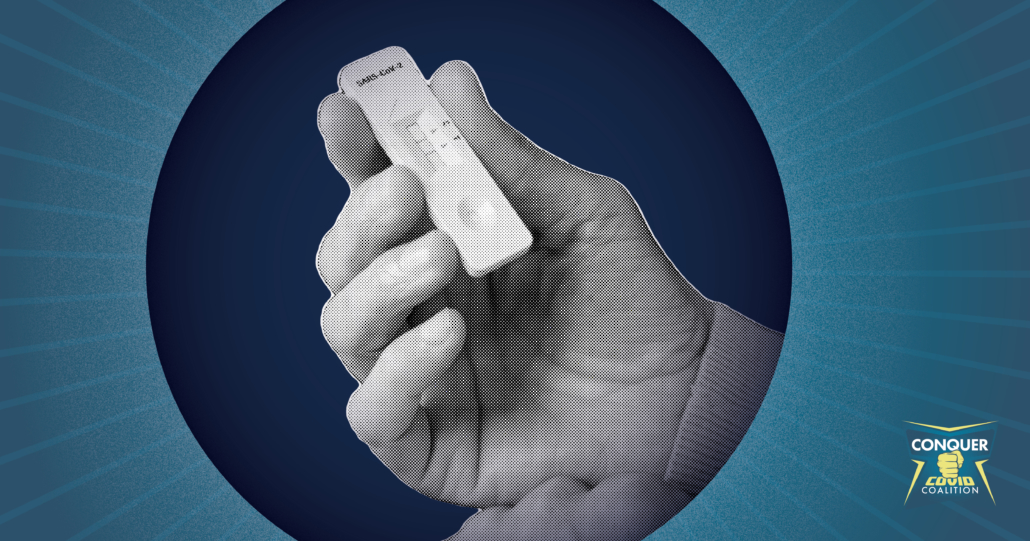3 Things to Know About At-Home COVID-19 Tests
Many at-home antigen tests can provide the information you need to make informed decisions about your health
At-home COVID-19 testing kits are in high demand. With the Omicron variant taking a toll on our communities, getting test results at home within 15 minutes is not only convenient, but can help mitigate the spread.
While these tests have limitations, they are an essential tool as COVID-19 surges continue to impact daily life.
“We’ve often said testing is like the headlights on our car in the middle of winter – It’s the same.”
“It is our way to see this virus, to see where it’s spreading and just empower Alaskans to have the individual information themselves so that they know if their runny nose and sore throat is COVID or if it’s not, because that can help minimize your chances of spreading it to someone else.”
1. What is an at-home, rapid antigen test?
COVID-19 self-tests (also referred to as at-home tests or over-the-counter (OTC) tests) are one of many risk-reduction measures that protect you and others.
These tests can detect SARS-CoV-2 to inform you of an infection at the time of the test. This type of test is a “viral” test because it looks for viral infection. An antigen test is an example of a viral test.
2. How accurate are these tests?
A positive self-test means that the test detected the virus, confirming a positive infection.
“If it’s positive, that’s it. You have the coronavirus,” Chief Infection Control Officer at MD Anderson Cancer Center, Roy Chemaly, M.D., says. “But if it’s negative, that doesn’t mean you don’t.”
A negative self-test result means that the test did not detect the virus and you may not have an infection, but it does not rule out infection. Repeating the test within a few days, with at least 24 hours between tests, will increase the confidence that you are not infected.
If you take a test during the earliest phase of infection, before the virus has replicated widely, the test could return a false negative.
One study suggests that rapid antigen tests are most accurate when a person has symptoms.
Some at-home rapid antigen tests have an overall sensitivity of roughly 85 percent, which means they are catching approximately 85 percent of people infected with the virus and missing 15 percent. In some studies, their real-world performance has been even lower.
Using the tests repeatedly — to routinely screen students for the virus, for instance — can compensate for their lower sensitivity. In one recent study, researchers found that when they tested infected college students and employees every three days, rapid antigen tests successfully identified 98 percent of infections, on par with P.C.R. tests.
3. New Developments
With multiple variant surges in the fall, the demand for at-home tests rose. The U.S. was unprepared, and stores couldn’t keep the tests in stock.
To increase access to rapid tests for all consumers, the Biden-Harris Administration is now requiring insurance companies and group health plans to cover the cost of at-home COVID-19 tests. Beginning January 15, 2022, individuals who have private health insurance or who are covered by a group health plan will be able to have at-home test costs covered.
President Joe Biden also announced that 500 million free at-home, rapid COVID-19 tests would be shipped to Americans’ homes. On Wed., Jan. 19, people can begin ordering free at-home tests at COVIDTest.gov. The first tests will ship out in late January or early February.
Additionally, top retailers that sell at-home, rapid COVID-19 tests–Walmart, Amazon, and Kroger–will offer to sell those tests at a lower cost for the next three months. This means that individuals will be able to buy these tests at their local retailers or online for up to 35 percent less starting by the end of this week.
Your Health is in Your Hands
At-home tests are a powerful tool for taking control of your health. They are a convenient tool for reducing risk, along with vaccination, masking, and physical distancing, that protect you and others by reducing the chance of viral transmission. Even if you don’t have symptoms or are fully vaccinated, you can self-test to make decisions that will help prevent spreading COVID-19 to others.
What to do if you test positive
If you test positive, you should isolate and inform your healthcare provider and any close contacts.
A positive self-test result means that the test detected the virus, and you are very likely to have an infection. You should stay home or isolate yourself for ten days, wear a mask if you have contact with others, and avoid indoor gatherings to reduce the risk of spreading the disease to someone else.
A negative self-test result means that the test did not detect the virus and you may not have an infection, but it does not rule out infection. Repeating the test within a few days, with at least 24 hours between tests, will increase the confidence that you are not infected.
For more information, follow the CDC recommendations.
Information provided by the Centers for Disease Control and Prevention, New York Times, the White House, and the U.S. Department of Health & Human Services.




